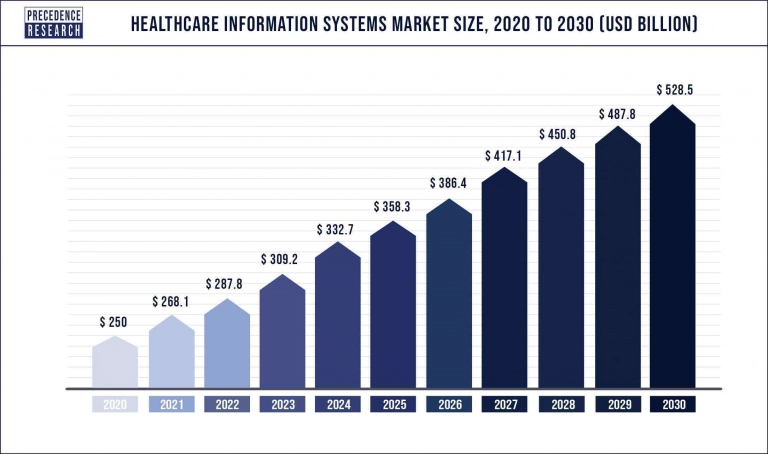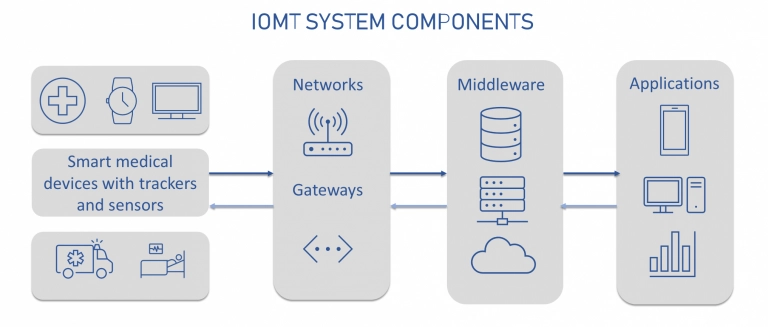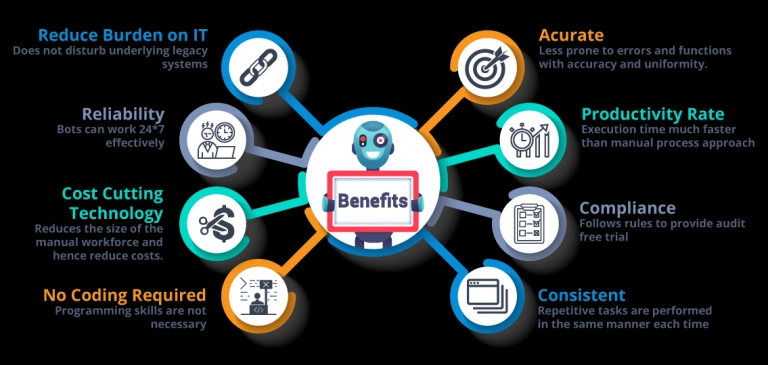The year 2025 is anticipated to boost the healthcare sector with ground-breaking discoveries and technologies. Most of the major modifications are still in the future! The health tech market capitalization reached $98 billion in 2024, and that's only according to the index including 34 companies (source ). This means higher competition between healthcare organizations and more money being invested in the latest technology.
The US healthcare industry is expanding quickly; by 2026, the national healthcare product's value is predicted to reach $6 trillion (source ). Keep reading and learn about the latest healthcare software development trends, including value-based care, robotic automation, remote care, smart healthcare systems, and many more.
Healthcare IT market 2025-2030
Precedence Research estimates that the global market for healthcare information systems would likely reach $528.5 billion by 2030. Therefore, it is not surprising that healthcare IT trends are rapidly gaining popularity.

Healthcare IT market size (source).
The global market for healthcare information systems is expanding due to the increased demand to reduce paperwork. One of the main market expansion drivers is government initiatives to transform healthcare facilities digitally. In addition, the market growth for healthcare information systems is significantly impacted by development strategies like new product launches, partnerships, and collaborations.
The healthcare sector is adopting technologies at a fast pace and this trend drives the market for healthcare information systems. Healthcare information systems provide data management and security for data connected to healthcare and significantly impact the price and standard of service provided.
Personal and electronic health records are among the most frequently used healthcare information systems. The rising government spending has significantly influenced the growth of the worldwide market for healthcare information systems in the creation and digitization of healthcare infrastructure.
The world's growing senior population, rising occurrences of traffic accidents, and increased frequency of chronic illnesses are all contributing to an increase in hospital admissions. The enormous amount of patient-related data must be effectively handled and stored cost-effectively.
Build and revamp interoperable healthcare solutions: enable remote health monitoring and adhere to the HIPAA standard
Top 15 healthcare trends
Recent interoperability regulations , patient-centered care, and, of course, the pandemic have made healthcare organizations rethink their software capabilities. The power of healthcare IT systems has become essential for market success. Changes in healthcare regulations and approaches have resulted in the following healthcare technology trends.
1. Value-based care
Among all the healthtech trends in 2025, this one is the most promising. According to Medical Economics report, 74% of the clinics that made investments in value-based care increased the number of employees, while 71% increased technology to help with the move read more here .
Even though the transition to value-based care is far from finished, healthcare organizations gradually adapt their approaches. They abandon the fee-for-service model and start to measure the success of treatment based on results, not the number of checkups or tests completed.
It becomes more reasonable to prevent health issues than to deal with protracted symptoms. Healthcare organizations connect EHRs with third-party health apps to predict what may happen to a person and know how to best deal with it. Learn how to integrate Epic , Cerner, and Meditech here.
The transformation toward patient-centered care is a time-consuming process that may take years. Hence, providers design new care models and adopt software that collects patient health data for useful insights.
2. Operational analytics
Clinicians have been complaining about burnout for a long time. The pandemic has made things even worse. The limited hospital capacity and understaffed facilities have resulted in increased workload and financial losses. It has started a wave of healthcare trends focused on optimization through operational analytics tools and data usability.
By 2026, the market for healthcare analytics is anticipated to be worth $75.1 billion, growing at a CAGR of 28.9% (source). Healthcare analytics tools and services make it possible to comprehend and reveal aspects like historical data trends and the financial and operational performance of healthcare institutions.
Such software analyses massive patient health data collected by an organization and turns it into actionable reports. Data-driven recommendations enable health systems to make quick decisions and streamline the work of multiple departments.
3. Cybersecurity
The size of the worldwide cybersecurity industry would increase from $173.5 billion in 2022 to $266.2 billion in 2027. The industry is growing as a result of more data breaches occurring globally, more people going digital, and more sophisticated cyberattacks.
Modern healthcare and technology go hand in hand. As healthcare organizations become more digital, problems related to data sharing also grow. Cybersecurity is and will remain one of the leading trends in healthcare. Over 93% of healthcare organizations have recorded data breaches in the past three years (source). To reduce these disturbing rates, care providers must ensure healthcare regulatory compliance, hire cybersecurity consultants, and educate staff about possible risks.
4. Strong network strategies
The mental health crisis has shown the importance of consumer-centric healthcare when all teams share the same data. That’s why, in 2025, healthcare organizations are moving to a community mindset and turning disparate health apps into a single system. They unite physicians, social workers, payers, and researchers in one network to facilitate cooperation.
Networking in healthcare can help you land top jobs in a profession that is predicted to increase by 32% over the next ten years (source). This trend is particularly noticeable when it comes to vaccination, for example. Without the joint work of multiple teams, it would be impossible to develop an effective COVID-19 vaccine so quickly. The same approach translates to other health initiatives that require quick discovery and deployment of innovative therapies.
5. Interoperability in healthcare
Interoperability is a high priority for providers, to integrate patient data from within and outside the system and merge clinical and administrative data to support patient care and business applications.
Interoperability is one of the most powerful healthcare industry trends that has gained traction for several reasons. First, recent ONC and CMS regulations require healthcare organizations to implement API-based data sharing in their systems. A range of standards defines how to connect multiple applications with EHRs and what data to share.
Besides, healthcare interoperability is essential to optimize the work of providers. Healthcare interoperability facilitates healthcare IT innovations since implementing new solutions becomes easier. Thanks to smooth data sharing, efficiency grows, unnecessary diagnostic testing decreases, and the communication between referring doctors improves. Interoperability can generate decent ROI for EHR systems.
6. Tailored patient experience and mobility
Apart from quality care, healthcare services also need to ensure patient engagement and retention. US healthcare is a competitive field where providers must guarantee a decent patient experience at every touchpoint. It makes healthcare organizations leverage electronic health records with advanced capabilities.
They connect electronic health records with CRMs to automatically send patients personalized messages across channels. Existing and potential customers receive critical notifications, sales and marketing offers through SMS, emails, apps, and robust patient portals. It increases customer satisfaction and makes people more likely to return to a specific provider.
With the spread of 5G technology, healthcare mobility also emerges as one of the key healthcare trends. In 2020, it saved $0.2 billion (source ). In 2025, the savings are expected to reach $11.5 billion. That’s why many healthcare and technology providers have already started to prepare their remote patient monitoring and telehealth systems for 5G.
7. Enhanced clinical efficiency
Increasing efficiency decreases healthcare budget savings, according to Medical Economics Journal . With the money saved, you can buy goods and/or services that are more difficult to access. Providing equitably priced healthcare for their population is crucial in settings with limited health budgets.
This year, many healthcare organizations invested in workflow optimization through EHR interoperability. By connecting their EHR systems with third-party health apps, they supply healthcare teams with more quality data collected in one place. It gives a 360-degree view of every patient and helps to deliver better care.
8. Internet of Medical Things (IoMT)
IoMT will experience exponential growth, even if it won't be a novel concept in 2025. Each of the several digital health developments in this sector offers fantastic applications to healthcare professionals, resulting in billions of dollars in cost savings. Wellness and remote health monitoring applications are popular now and will continue to grow by around 6% in popularity in 2025.
Some of those mobile applications can sync with wearables, like pulsometers or fitness trackers, to use information gathered from sensors placed on your body to report or analyze your health conditions, including pulse, body temperature, blood pressure, and other metrics.

Autonomous nursing robots or self-moving smart gadgets can substantially assist by minimizing the tasks linked to supply management or sanitary maintenance that medical professionals must perform.
An Italian hospital, for instance, employed robot nurses during a serious COVID-19 epidemic. These clever assistants were utilized to remotely check patients' blood pressure and oxygen saturation levels because they are two key indicators of their present state of health.
9. Remote Patient Monitoring (RPM)
Among the healthcare software trends, RPM is becoming more popular every year. By 2027, the global RPM systems market is expected to reach a value of over $1.7 billion, an increase of nearly 128% from the current market opportunity.
Remote Patient Monitoring Source
RPM stands out among the current developments in healthcare. COVID-19 also had a part in making remote patient monitoring a popular practice in the medical industry today. Online appointments, remote treatment, and video conferencing are just a few ways virtual healthcare is becoming more prevalent. Additionally, RPM has even more options thanks to the variety of IoMT devices.
In the long term, hands-free communication will be one of the most important revenue cycle management developments in healthcare technology. That's because RPM helps healthcare businesses of all sizes save time and money. When dealing with personal protection equipment during the epidemic, it excelled. When RPM is achieved in the future, it will be possible to give the ideal service appearance for various patient groups by combining hands-free and on-site treatments. Find more actionable information in our guide on Remote Patient Monitoring system development .
10. Robotic Process Automation (RPA)
Startups from all over the world will pour hundreds of millions of dollars into creating AI projects in 2025, including various robotic systems, which may enable them to reduce the cost of recruiting trained medical personnel.
The intention of using RPA in healthcare is to assist medical facilities that already have a severe shortage of nurses and clinicians as a result of the COVID-19 pandemic, which has put the entire healthcare system under unprecedented strain, rather than to replace people with machines, which would lead to unemployment and a decline in social standards.
Innovative enterprises should keep in mind the medical community's restrictions on AI-driven software, its capabilities, and its applications as they work to realize these lofty goals. Modern medicine has countless applications for robotic assistance and automated systems, including cleanliness, surgery, remote diagnostics, etc. However, the healthcare system's top goals will always be the well-being of medical personnel and the effective treatment of patients.

Benefits of RPA deployment Source
In light of this, robotic and AI-driven technologies will be employed to support current procedures rather than replace them, resulting in a potent fusion of the present and the future.
One of the most prominent technology trends in healthcare is the combination of bold initiatives and sound regulation. It will enable clinicians to utilize cutting-edge technology fully, learn to apply it in satisfying and secure ways, and steer clear of potential risks.
11. Cognitive automation (CA)
It is important to call attention to CA as one of the new developments in healthcare technology. The next-generation trend for real digital transformation is cognitive automation. The tech package and applicability are about to fundamentally alter an industry's management, but it is now one of the developing IT market trends in healthcare. It uses RPA's accomplishments but goes beyond repetitive jobs by modeling human behavior. In a nutshell, it functions as the healthcare organization's electronic brain.
In essence, CA uses ML algorithms to introduce decision velocity into the business while leveraging the automation capabilities of current software suppliers. Zettabytes of data may now be processed in a matter of seconds, and decision-makers can receive suggestions ready for acceptance and supported by current facts.
12. Cloud migration
The move to the cloud in healthcare is already well underway and is expected to increase significantly in the coming years. According to MarketsandMarketsTM, the global healthcare cloud computing market is expected to grow at a CAGR of 17.5% from an estimated $53.8 billion in 2024 to $120.6 billion by 2029 (source ). From our observations, the number of healthcare organizations that request cloud development services has increased significantly.
It solves numerous significant problems in service delivery, such as record management, remote care, and reaching patients with limited financial resources. Providers are using the cloud worldwide to effectively manage emails and electronic medical records (EMRs) and provide healthcare professionals with real-time data.
We can put into action the latest cloud computing trends in healthcare to improve customer engagement and streamline problem-solving by moving legacy call center operations to the cloud. Traditional health systems frequently restrict an organization's capacity to provide timely, affordable treatment and keep patients. Businesses can build omnichannel contact centers with conversational AI and automation, linked ecosystems, and security and compliance features that improve customer experiences by moving operations to the cloud.
13. Data breach prevention
Despite all the technological safeguards and healthcare providers' knowledge, there were 8% fewer occurrences in February 2022 than there were in January 2022. Nevertheless, a staggering 2.5 million people were impacted by these 46 instances.
Thousands of patients around the US are impacted by these data breaches. Hopefully, healthcare organizations will focus more on data security and their digital ecosystems in 2025. Healthcare cybersecurity is quickly emerging as a popular technological topic for this decade.
14. Consumerization
The medical sector now resembles a market for goods and services. Healthcare organizations that compete with them use marketing techniques to offer customers (patients) services.
Many providers are willing to meet their requirements when a patient wants a certain medical service. The only businesses that will succeed in the long term in their fields are those that comprehend their customers and adjust to their complex needs. Thus, the consumerization of healthcare becomes a "must".
On websites like Walmart and Amazon, you may already obtain medications and medical supplies made by renowned companies. In 2021, more businesses will enter the internet market, offering thorough details about their rates and utilizing e-pharmacy, telehealth, and retail care.
15. Reimbursement
Due to investors' worries about the expensive cost of research and equipment, ambiguous pricing models and administrative processes, a tiny patient population, and a lack of thorough safety and efficiency data, there is a real issue concerning reimbursement of telemedicine .
Reinsurance, dynamic pricing, and formulae based on outcomes and income perform significantly worse than an annuity-based approach. These choices are characterized by ineffective control and the participation of several insurers, which results in confusion and disarray.

Reimbursement market (source)
According to experts, the widespread adoption of an annuity-based reimbursement model will give gene therapy projects the stable financial foundation they need to cover costs related to research and the use of cutting-edge technologies as well as enable them to generate $2 billion in revenue in 2021.
Want to become HIPAA-compliant?
Learn about best practices of FHIR implementation.

Our experience
Binariks is a healthcare software development company that offers all kinds of healthcare trends that we’ve seen here. Let’s look at our case studies related to trends in health information technology.
Interoperability
The client’s product simplifies the routines for general practitioners, primary care physicians, specialists, and medical office managers by enabling e-referring between various electronic health records with FHIR-API exchange.
Our client was planning to integrate the platform with as many EHR software providers to automate the electronic record referral and ensure the security of data exchange between EHRs. Binariks team helped the client with the following challenges:
- Analyzed which EHR providers could be integrated with the platform
- Created solution architecture that meets the requirements of HIPAA and ensured secure health data exchange when the platform got integrated with other EHR providers
- Enabled interoperability and automated generation of electronic referrals and transferring e-health data from one EHR system to another
- Analyzed which EHR providers can be integrated with the platform
Our client has adopted HL7 FHIR release 4.0.1 as the foundational data exchange standard to ensure the security of patient health data through APIs.
Patient management
The client is a Spanish healthcare provider that applies and provides software solutions for patient management. He aimed to develop a web platform to provide doctors with multiple patient management functionalities for patients and healthcare providers. The client already had an unfinished web platform, which required significant optimization.
Our team took ownership of the project while cooperating with the client’s subject matter expert. We delivered a highly-scalable web application with PHP Laravel backend and Angular frontend.
Database management
CareBridge is a healthcare technology corporation that facilitates care for individuals receiving long-term support services. It needed to rewrite the existing Object C application in Swift, upgrade the Android app, and launch a new product. Since the scope of ongoing work was massive and strained the internal resources. Although the project has just started, our team has already rewritten the legacy Objective C iOS application in Swift and addressed multiple feature requests for the Android app.
Our engineers built the platform:
- Electronic visit verification
- Data aggregation for real-time clinical information sharing
- exchange important details on patients’ health of members, health plans, caregivers, and state officials.
Binariks worked with the customer’s team to provide database management, backend maintenance, and coding services.
Future of healthcare technologies
Healthcare technology will advance in every aspect as 2025 progresses. Despite industry-wide security improvements, threats are constantly changing and must be dealt with via prevention rather than reaction. Because of ground-breaking and developing technologies like artificial intelligence, machine learning, and extended reality, the quality and effectiveness of healthcare will keep improving.
When selecting how to update your healthcare company., time and money are at stake You must work with the best group of software developers who are aware of your requirements and goals.
EHR interoperability, consumer-centric healthcare, cybersecurity, and other 2025’s healthcare trends show that market leaders opt for efficiency. Hence, in the upcoming years, the need for workflow optimization and interoperability will only grow.
If you need any assistance with healthcare software integration or development, contact Binariks . We have completed multiple projects of different complexity for healthcare organizations worldwide.
FAQ
Share

